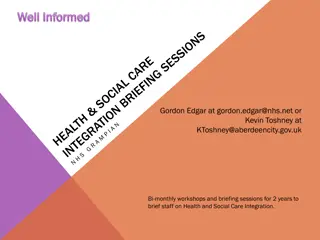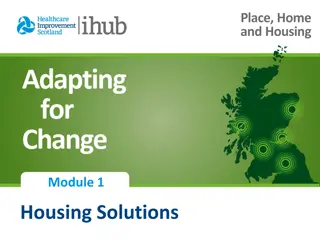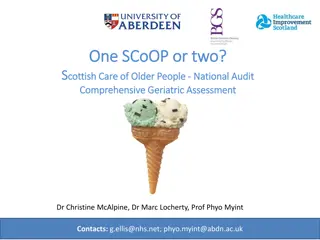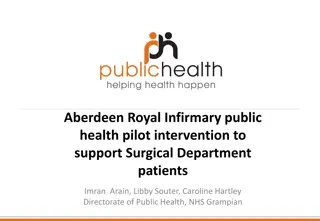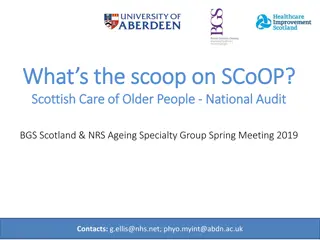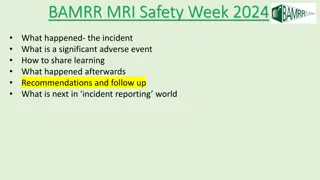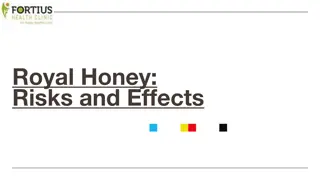
Diabetes-Specific Psychological Distress in Type 2 Diabetes Mellitus
Explore the impact of diabetes-specific psychological distress in Type 2 Diabetes Mellitus using the PAID scale. Learn about the prevalence, associated problems, and the importance of screening and holistic care approaches to improve outcomes. National recommendations for psychosocial management in India are also highlighted.
Download Presentation

Please find below an Image/Link to download the presentation.
The content on the website is provided AS IS for your information and personal use only. It may not be sold, licensed, or shared on other websites without obtaining consent from the author. If you encounter any issues during the download, it is possible that the publisher has removed the file from their server.
You are allowed to download the files provided on this website for personal or commercial use, subject to the condition that they are used lawfully. All files are the property of their respective owners.
The content on the website is provided AS IS for your information and personal use only. It may not be sold, licensed, or shared on other websites without obtaining consent from the author.
E N D
Presentation Transcript
Diabetes Specific Psychological Distress in Type 2 Diabetes Mellitus, using the PAID scale diabetes-main Dr Lydiya Thomas, Dr Hesarghatta Shyamasunder Asha Dr Raja Edwin Amalraj, Mr Prakash R Dr Prakash Abraham, Prof Nihal Thomas
INTRODUCTION Diabetes is an important public health challenge1 More pronounced in India Type 2 (90%)2 Number of diabetic subjects (million) in India2 Focus of treatment on lifestyle and pharmacological methods However studies also identified a significant association between psychological distress and diabetes 1. 2. World Health Organisation (WHO). Diabetes Fact sheet N0312. 2013. Available at: http://www.who.int/mediacentre/factsheets/fs312/en/. [online]. Accessed on 31/08/2014. Mohan V, Sandeep S, Deepa R, Shah B, Varghese C. Epidemiology of type 2 diabetes: Indian scenario. Indian J Med Res 2007 Mar;125(3):217-230.
Diabetes Specific Psychological Distress (DSPD) The burden of self-care and pharmacological therapy overwhelm or burn-out patients3 Adjustment to the disease associated with anger, guilt, frustration, denial and loneliness4 The potential influence of diabetes on life-expectancy and the impact of long-term complications fear and depression3 3. 4. Lloyd CE, Pouwer F, Hermanns N, ed. Screening for Depression and Other Psychological Problems in Diabetes: A Practical Guide. London: Springer-Verlag; 2013. Polonsky WH. Understanding and Assessing Diabetes-Specific Quality of Life. Diabetes Spectr. 2000;13(1):36.
DSPD Prevalence: 18-52%3 Specific to diabetes Associated with depression, reduced QoL, poor diabetes self-care and impaired glycaemic control Earlier diagnosis and treatment known to improve outcome Holistic/ patient-centred model of care National recommendations suggests screening using questionnaires5 3. 5. Lloyd CE, Pouwer F, Hermanns N, ed. Screening for Depression and Other Psychological Problems in Diabetes: A Practical Guide. London: Springer-Verlag; 2013. Kalra S, Sridhar GR, Balhara YPS. et al. National recommendations: Psychosocial management of diabetes in India. Indian J Endo and Meta 2013 May;17(3):376-380
PROBLEM AREAS IN DIABETES (PAID) Well-validated, easy-to-administer, 20-item scale Uses a five-point Likert scale Shown to correlate strongly with DSPD 6. Welch G, Weinger K, Anderson B, Polonsky WH. Responsiveness of the Problem Areas In Diabetes (PAID) questionnaire. Diabet Med. 2003;20(1):69-72.
Somewhat serious problem 3 Not a Problem Minor Problem Moderate Problem Serious Problem S.No. Questionnaire 1.Not having clear and concrete goals for your diabetes care? 2.Feeling discouraged with your diabetes treatment plan? 3.Feeling scared when you think about living with diabetes? Uncomfortable social situations related to your diabetes care (eg. People telling you what to eat)? 5.Feelings of deprivation regarding food and meals? 6.Feeling depressed when you think about living with diabetes? 7.Not knowing if your mood or feelings are related to your diabetes? 8.Feeling overwhelmed by your diabetes? 9.Worrying about low blood sugar reactions? 10.Feeling angry when you think about living with diabetes? 0 1 2 4 0 1 2 3 4 0 1 2 3 4 4. 0 1 2 3 4 0 1 2 3 4 0 1 2 3 4 0 1 2 3 4 0 1 2 3 4 0 1 2 3 4 0 1 2 3 4
Somewhat serious problem 3 Not a Problem Minor Problem Moderate Problem Serious Problem S.No. Questionnaire SCORING Ranges from 0-100 11.Feeling constantly concerned about food and eating? 12.Worrying about the future and the possibility of serious complications? Fellings of guilt or anxiety when you get off track with your diabetes management? 14.Not accepting your diabetes? 0 1 2 4 0 1 2 3 4 Summing 0-4 responses 13. 0 1 2 3 4 to 20 PAID items & 0 1 2 3 4 multiplying the sum by 15.Feeling unsatisfied with your diabetes physician? 16.Feeling that diabetes is taking up too much of your mental and physical energy every day? 17.Feeling alone with your diabetes? Feeling that your friends and family are not supportive of your diabetes management efforts? 19.Coping with complications of diabetes? 20.Feeling burned out by the constant effort needed to manage diabetes? 0 1 2 3 4 1.25 0 1 2 3 4 Score of 40 denotes elevated levels of 0 1 2 3 4 distress 18. 0 1 2 3 4 0 1 2 3 4 0 1 2 3 4
AIMS Primary aim To establish the prevalence of DSPD among type 2 diabetes outpatients at a south Indian tertiary hospital, using the PAID questionnaire. Secondary aims To study the relationship between socio-demographic factors and the level of diabetes-specific psychological distress. To explore the level of acceptance of PAID scale by the Indian subjects.
METHODS Cross-sectional single centre study Setting Christian Medical College, Vellore, Tamil Nadu, India 7th Jan 11th Feb 2015 Subjects T2DM patients, aged >18ys, attending the diabetes outpatient dept Ethics Approved by the Institutional Review Board (IRB) and Ethics committee of CMC
DATA COLLECTION Informed consent obtained Two sets of questionnaires 1) PAID - Available in two languages (English & Tamil) 2) Satisfactory questionnaire Socio-demographic and clinical characteristics Acceptance of PAID
Comorbidity (self-reported): Number of additional illness What is your age? 16 to 24..... Are you male or female? Male.... Female ........ Residential Place Rural.... Urban..... Highest level of education. Illiterate.... Primary... Marital Status 25 to 44..... 45 to 64... .. 65+..... 0.. 1.. 2.. 3.. 4.. 5.. 5+.. Number of anti-diabetic medication 0.. 1.. 2.. 3.. Adherence to diabetic medication Yes - always.... Yes sometimes Did you find PAID easy to complete? Yes...... No... Which questions did you find confusing? 1 . . 20 Which questions would you not be happy to answer? 1 . . 20 Will you happy to complete this questionnaire again?. Yes definiately Yes maybe The questions in PAID are appropriate to Indian population 4.. 5.. 5+.. No... Secondary . College &above.... Unmarried... Smoking Non-smoker...... Alcohol use Yes........ Employment at present Employed ...... Duration of (diabetic) illness <1yr.. 1-2yrs... 2-5 yrs.... Height (m) Weight (kg) Married.... Separated/divorce/widow(er). Smoker ...... Ex-smoker ....... No......... No.. Unemployed...... 5-10 yrs... >10 yrs...
DATA ANALYSIS Epidata Software Stata 13.1
RESULTS Demographics 253 questionnaires were completed Male : Female = 157 : 96 61.3% were aged between 45 to 64 50.2% had T2DM for >10yrs 70.0% reported one or more complications
Self-reported complications of diabetes 177/253 (70.0%) 120 42.7% 100 34.0% 32.4% 80 27.3% 60 40 12.3% 7.5% 20 0 1 Neuropathy Foot problems Retinopathy PVD CAD Nephropathy
PREVALENCE OF DSPD The PAID score ranged between 12.5 45.0 One-third of the patients had greater level of psychological distress (Score 40: 83/253, 32.8%) All 20 items on PAID were scored as a serious problem (score=4)
Line graph: frequency in which the 20 PAID items were scored as a serious problem Feeling angry 41 Feeling burned out 27 Worrying about low blood sugar 36 Coping with complications 15 Feeling overwhelmed 34 Friends and family unsupportive 12 Mood related to diabetes 18 Feeling alone 14 Diabetes taking up too much energy Feeling depressed 35 27 Feeling of deprivation 21 Feeling unsatisfied with doctor 9 Uncomfortable social situations 16 Not accepting diabetes 30 Feeling scared 32 Feeling of guilt 35 Worry about future and complications Feeling discouraged 17 53 Constantly concerned about food 25 Not having concrete goals 31
Adjusted OR and Its 95% CI from multiple logistic regression P = 0.032 Presence of retinophathy P = 0.009 Age: 45 to 64 yrs P = 0.010 25 to 44 yrs Risk Factors No. of Complications: 1 2 >2 Body Mass Index (Wt/Ht msq) 0 2 4 6 8 10 Odds ratio
Adjusted OR and Its 95% CI from multiple logistic regression Statistically Insignificant Gender Educational, employment & marital status Duration of diabetes Regardless of the duration of diabetes 1/3rd had DSPD
ACCEPTANCE OF PAID 250 90.1% 84.6% 83.0% 200 Number of participants 150 Yes Yes maybe No 100 50 0 Easy to complete Complete again Appropriate to Indian population
DISCUSSION First study to use PAID in India Worrying about future complications, anger, guilt, depression and feeling overwhelmed by diabetes were key problems noted PAID easy to administer Acceptable Helps identify concerns of individual patients Individual concerns can be specifically addressed during counselling sessions Limitation: Effect of intervention not studied
CONCLUSION 1/3 of patients with diabetes have significant psychological distress PAID easy to administer and acceptable Further longitudinal studies to assess the effect of interventions are recommended







